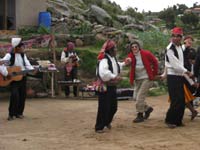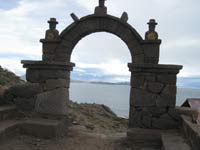Puno and Lake Titicaca, Peru
Click on the thumbnails below to get larger photos
We arrived in Puno by bus in the late afternoon from Arequipa, after a fairly pleasant drive of some 6 hours across the Alto Plano. Puno is a city on the shore of Lake Titicaca, with a population of some 100,000. It was founded in 1668 by the Spanish viceroy Pedro Antonio Fernández de Castro and called San Juan Bautista de Puno. The name was later changed to San Carlos de Puno, in honour of King Charles II of Spain. It now just Puno. There are several churches dating back from the colonial period, when they were built to service the Spanish population and to convert the natives.
Puno is squeezed on a small flat area between Lake Titicaca and the mountains surrounding the city. The growing city has now expanded up the hillsides. Puno's elevation is 3,822m, which means it is fairly cold at night. I suffered the headaches of altitude sickness, a condition for which I never realised that I had a predilection, probably because I had never spent time at this sort of altitude.
Click on the thumbnails below to get larger photos
 |
 |
 |
 |
| Puno Plaza Hotel was, as you might expect, on the Plaza de Armas. The view from our room window was over the Plaza. |
We stayed two nights at the Puno Plaza Hotel, which stands on the Plaza de Armas. We had a room overlooking the square and thought that it was the place to be. I can understand that some may want a "quieter" room, but for me people gazing over the plaza is part of the stay.
The hotel is not "luxurious" but has lots of local character - in other words you are staying in Peru here, not in a homogenized chain hotel.
The front desk are very helpful. We were put in a back room to start (they have no windows -well they have daylight from a light shaft - and perhaps they offer these to foreigners as some have complained of the noise at the front). We had the opposite problem and asked for a light, airy room at the front, and they were happy to oblige. You probably need to book one or the other sort in advance according to preference.
However you do not come here to see the city of Puno but to partake on two trips on Lake Titicaca.
- Floating Islands, the Uros Islands. The boats go to different islands every day, in order to spread their income from tourists as fairly as possible. The islands themselves are made of reeds as well as the people's houses and their boats.
- The Islands of Taquile or Amantani where you can sleep over with a local family. We could not manage the home stay, but visited Taquile.
The next morning we were picked up by a decrepit old bus and driven to the harbour of Puno. Here we boarded an even more decrepit boat to take us out on Lake Titicaca - null points to Rickshaw Travel for organisation here. First stop was one of the floating reed islands which were quite spectacular. The people of the Uros Islands, who predate the Incas, speak the Aymara language. It is thought that they may have fled to the islands to escape the Incas. The islands can, of course, be moved and have been in recent years because of the Shining Path revolutionary movement in Peru, the islands were towed nearer to the mainland for safety. Happily for the inhabitants, this made the islands easier for tourists to reach, and now tourism is the most important contributor to the islands' economy. A "hotel" has opened on one of the islands, and you can now stay overnight if you fancy it
Early schooling is done on several islands, including a traditional school and a school run by a Christian church. Older children and university students attend school on the mainland. The larger islands house about ten families, while smaller ones are home to only two or three. The island we actually visited had four houses.
The islets are made of totora reeds from the lake. The dense roots of the reeds are cut to form a floating platform one to two meters thick to support the islands. Then layer on layer of reeds are added to make the finished island, which is then anchored in its final position. The islands are topped up with fresh reeds annually, and with regular maintenance, will last about 40 years before they need replaced with a new island. It then takes the families about a year to make the new island.
As we walked over "our" island, we found our feet "gave" 2 or 3 inches, and the sensation is quite odd. Food is cooked with fires placed on piles of stones. And the "banos" are tiny 'outhouse' islands near the main islands. They say that the ground root absorbs the waste!
Click on the thumbnails below to get larger photos
 |
 |
 |
 |
| Our tour boat nosed out into the lake soon after dawn, and we soon came to the Floating Islands village. They showed us how they .. |
 |
 |
 |
 |
| ..made the islands from reeds, and how the houses and kitchens were added. The locals were obviously keen to sell the products .. |
 |
 |
 |
 |
| ..that they made on the island. All ages were there, including the very young. Each island takes it in turn to host tourists, so this island .. |
 |
 |
 |
 |
| ..will have to wait some time before it welcomes tourists again - there being about 40 islands . We were then ferried across to another .. |
 |
 |
 |
 |
| ..island, which had the community centre and, would you believe it, more woven fabrics. These shots give some idea of the extent of the |
 |
 |
 |
 |
| ..village, and the different islands. This is the "hotel" on one island. This is the locals harvesting totora reeds to maintain the islands. |
Our boat trip then ventured out further onto the lake for another couple of hours to get to the island of Taquile. On Taquile we had lunch and watched "traditional" dancing. Inevitably it is a bit of a tourist mill, and there is certainly no spontaneity in what the indian natives are doing. Isla Taquile is a normal, non-floating, island in the Peruvian side of Lake Titicaca. Tourism is they say strictly controlled by the island elders to maintain the island's culture - I had my doubts about this..
About 2,200 people live on the island, which is 5.5 by 1.6 km in size. The inhabitants, known as Taquileños, are southern Quechua speakers. Taquileños are known for their fine handwoven textiles, which are regarded as among the highest-quality handicrafts in Peru. Knitting is exclusively performed by men, starting at age eight. The women exclusively make yarn and weave.
Taquileños run their society based on community collectivism and on the Inca moral code ama sua, ama llulla, ama qhilla (Quechua for "do not steal, do not lie, do not be lazy"). The economy is based on fishing, terraced farming ( mainly potato cultivation) and tourist-generated income from the approximately 40,000 tourists who visit each year. One can see that this is 100 tourists per day on average, but the average will be skewed by seasonality
We had lunch of a vegetable soup, fish with rice and a tomato and onion salad in one of the community restaurants for tourists, followed by "traditional" music and dancing. The pot for "tips" now appears as part of the show.
Click on the thumbnails below to get larger photos
 |
 |
 |
 |
| We landed on Taquile and climbed a fair way up through the terraced fields, to reach a communal restaurant for lunch. The island is .. |
 |
 |
 |
 |
| ..very fertile and potatoes seem very abundant. After lunch, there was a traditional dance put on for us, and one could see them busy .. |
 |
 |
 |
 |
| ..weaving if they were women, knitting if they were men. Then a further climb to the main square, where a band was marching, before .. |
 |
 |
 |
 |
| dropping down, via more potato fields, to the sea, and our boat 2.5 hour boat trip back to Puno. And this is the restored SS Yavari |
After the trip back to Puno, I decided to go and see the travel company who ran the boat trip - the old boat was a death trap if it had sunk, and given its age and condition that was a distinct possibility - there were 5 clapped out life jackets at the disposal of the 40 people on board. The water in the Lake is 8 degrees, so survival time would be short in the event of a sinking. Net result of it was the next morning 2 girls and a driver came to hotel to give us a free trip to the bus station, and they threw in a ethnic chess set. We all ended friends.
There was just time for dinner before bed, and another early start for the bus to Cusco, this time on a Tour Peru bus as Cruz del Sur do not run the Puno-Cusco route.
On to Cusco
Our trip to Peru



















































